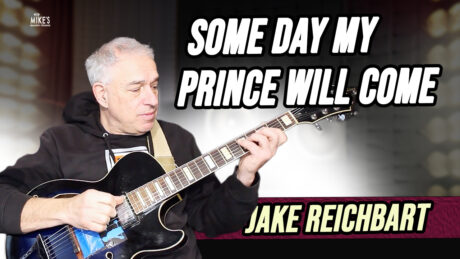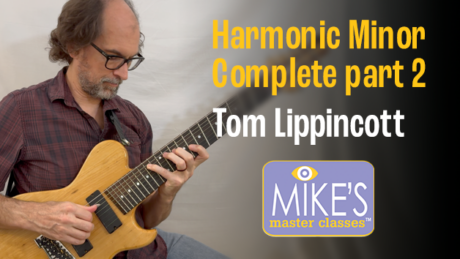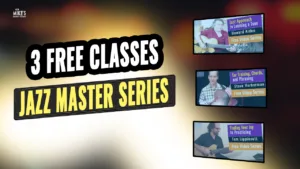Melodic Minor Complete part 1: Theory
The ascending, or “jazz”, melodic minor scale is one of the most central and recognizable sounds in jazz. Late 19th and early 20th century composes like Debussy and Stravinsky used this sound in their music, and jazz musicians soon afterward began to adopt this tonal color. Melodic minor has become an essential part of any developing jazz musician’s vocabulary, and mastery of this scale is considered to be mandatory.
Because the melodic minor scale is so prevalent and has been in widespread use for so long, there are a multitude of instructional materials available covering the use of this scale in jazz. Many jazz musicians, however, don’t have a thorough or complete understanding of the theory behind the use of the scale, and still more don’t have as extensive a mastery of the structure as they could. This two-part class presents the melodic minor scale in a thorough, complete way, with the goal of giving a total understanding of how it has been, and continues to be, used by master jazz musicians.
Part one of the class breaks down the theory, revealing how, why, when, and where to use the scale and providing a clear explanation of the modes and many different techniques to make learning and utilizing them easier. Part one could be used by any jazz musician interested in gaining a more expansive knowledge of the melodic minor scale. Guitar fingerings and tablature are given, but traditional musical notation is also used throughout so that any instrumentalist or vocalist can benefit.
Part two of the class, which is more guitar-centric, presents a methodical and comprehensive way to gain mastery over the melodic minor scale, with numerous examples and exercises for increasing fluency. Part two also presents some imaginative and exciting ideas for generating new musical sounds with the scale, both for comping/chordal playing and single-note soloing.
Melodic Minor Complete part 1: Theory covers:
• basic structure and sound of the scale
• detailed breakdown of the seven modes, including different common names for each
• shortcuts for remembering which melodic minor scale goes with which chord and/or usage
• use of the augmented major seventh upper structure for all seven modes, with shortcuts for remembering which chord or arpeggio goes with which usage
• tritone substitution and its relationship to the Lydian dominant and altered sounds
• the “modal” modes and their uses
• the minor IV to I progression and its relationship to the Lydian dominant sound
• an alternate, internally-consistent way of conceptualizing the seven modes
• real-world examples of each of the uses of the melodic minor modes
• three easy fingerings for the augmented major seventh arpeggio that guitarists can use as a quick-start approach to the melodic minor sound
• running time: 104 minutes
• includes18 pages of written examples and exercises
• All musical examples from the video are provided in music notation, and guitar-specific examples are given in tablature and music notation.
• Each example performance in the video is titled and numbered for easy navigation.
• MP3 backing tracks for written examples
Class Content
| Melodic Minor Complete - Part I: Theory | |||
| Melodic Minor Complete – Part I: Theory | 01:44:00 | ||












A lot of great information
I’m always really impressed with how much information Tom provides in his classes, and this one is no exception. There is so much depth that you never feel as if you’ve learned something superficially, and he emphasizes the need to take what you’ve learned and keep working at it to get a deeper understanding of the material. Really looking forward to part II of this class.
by DAVID TARDIOAnother home run! Tom’s classes are the best. The course description will give you a good of idea of what to expect. What it doesn’t convey is what a great instructor Tom is. His way of presenting the material is great. He makes things easy to understand and incorporate in your own playing. I own quite a few of his videos and have been very happy with all of them. His videos are destine to become classics! Highly recommended!!
by Franklin BrownMelodic Minor Complete - Part 1
Excellent. I especially appreciate Tom’s urging to not get complacent with the introduction, but to continue to explore all that this fascinating scale has to offer.
by Dane ClarkeFirst class of Tom’s for me, I really enjoy his style. Very informative, clarified a lot of concepts. I’m looking forward to picking up some follow-on classes.
by Glenn BetcherNot knowing more then just a basic melodic minor scale i got this lesson. At first when looking at the material i was a bit let down that some of the stuff i was hoping for was in the second class. Well it was not without reason. In this class tom talks about the theory of the MM scale and gives shortcuts for getting started with the scale. Its just perfect and so well tought of. It really is the best way to aprouch this for me, cant wait to have this under my belt and start with the second class. If you really want more out of this scale both classes are a must, i bet i will get as much freedom with the MM scale as with the major scale when knowing and understanding both classes. Knowledge is power…… i want more 😉
by Robert GajadharWith this class u ll understand how the melodic scale is built and how u can get the best of it! Amazing work!
by laurent GILHODESI live in rural area and jazz players are in short supply around here–Tom Lippincotts classes are among the best resources for learning jazz guitar that I’ve found.
by Seth CuppyI have been studying from his classes for over a year at this point.
I think that the word "theory" in the title could be a little misleading. Actually, I find the information provided quite practical: if you are new to the scale you are going to immediately start using some cool sounds in some cool contexts, and if you’re not totally new you might get some unexpected tips here. I also recommend this class to teachers for the clarity, focus and progressiveness of Tom’s approach. Just as usual.
by Pedro Munoz